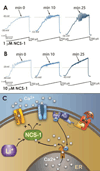Implications of gamma band activity in the pedunculopontine nucleus
- PMID: 26597124
- PMCID: PMC4877293
- DOI: 10.1007/s00702-015-1485-2
Implications of gamma band activity in the pedunculopontine nucleus
Abstract
The fact that the pedunculopontine nucleus (PPN) is part of the reticular activating system places it in a unique position to modulate sensory input and fight-or-flight responses. Arousing stimuli simultaneously activate ascending projections of the PPN to the intralaminar thalamus to trigger cortical high-frequency activity and arousal, as well as descending projections to reticulospinal systems to alter posture and locomotion. As such, the PPN has become a target for deep brain stimulation for the treatment of Parkinson's disease, modulating gait, posture, and higher functions. This article describes the latest discoveries on PPN physiology and the role of the PPN in a number of disorders. It has now been determined that high-frequency activity during waking and REM sleep is controlled by two different intracellular pathways and two calcium channels in PPN cells. Moreover, there are three different PPN cell types that have one or both calcium channels and may be active during waking only, REM sleep only, or both. Based on the new discoveries, novel mechanisms are proposed for insomnia as a waking disorder. In addition, neuronal calcium sensor protein-1 (NCS-1), which is over expressed in schizophrenia and bipolar disorder, may be responsible for the dysregulation in gamma band activity in at least some patients with these diseases. Recent results suggest that NCS-1 modulates PPN gamma band activity and that lithium acts to reduce the effects of over expressed NCS-1, accounting for its effectiveness in bipolar disorder.
Keywords: Arousal; Gamma oscillations; N-type; P/Q-type; Sleep/wake.
Figures




References
-
- Berdyyeva T, Otte S, Aluisio L, Ziv Y, Burns LD, Dugovic C, Yun S, Ghosh KK, Schnitzer MJ, Lovenberg T, Bonaventure P. Zolpidem reduces hippocampal neuronal activity in freely behaving mice: a large scale calcium imaging study with miniaturized fluorescence microscopy. PLoS ONE. 2014;9:11, e112068. doi: 10.1371/journal.pone.0112068. - DOI - PMC - PubMed
-
- Bergson C, Levenson R, Goldman-Rakic P, Lidow MS. Dopamine receptor-interacting proteins: the Ca2+ connection in dopamine signaling. Trends Pharmacol Sci. 2003;24:486–492. doi: http://dx.doi.org/10.1016/S0165-6147(03)00232-3. - DOI - PubMed
-
- Boucetta S, Cisse Y, Mainville L, Morales M, Jones BE. Discharge profiles. across the sleep-waking cycle of identified cholinergic, gabaergic, and glutamatergic neurons in the pontomesencephalic tegmentum of the rat. J N eurosci. 2014;34:4708–4727. doi: 10.1523/JNEUROSCI.2617-13.2014. - DOI - PMC - PubMed
Publication types
MeSH terms
Substances
Grants and funding
LinkOut - more resources
Full Text Sources
Other Literature Sources
Research Materials

